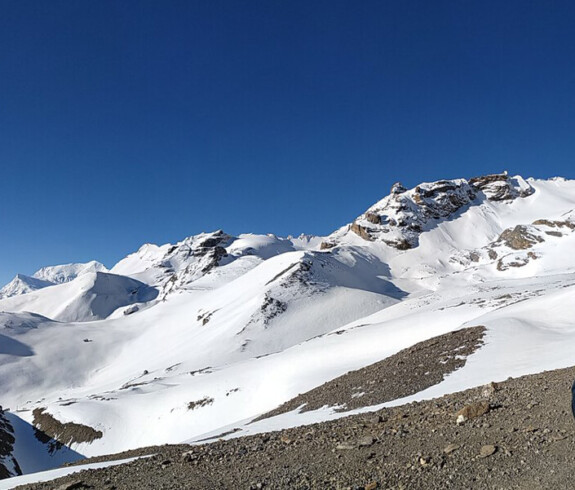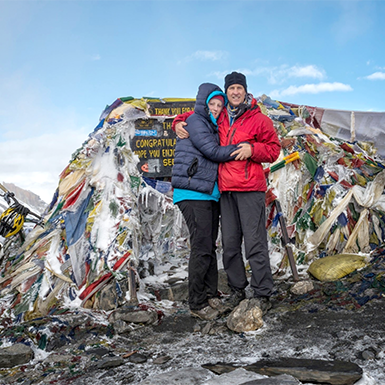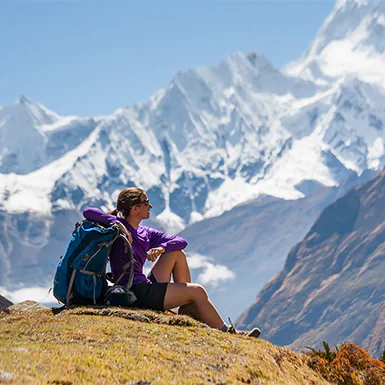We have officially started a series of travel blogs that include travel information. This section will go over the Annapurna Circuit Trekking Guide. The trek takes in the best of Nepal’s scenery, including stunning views of the Annapurna and Dhaulagiri ranges and landscapes ranging from subtropical to alpine heath and even semi-desert.
Even in life, it would be tough to do justice to trekking in Nepal because there is so much to see and do! Nepal is a safe place to visit, and the trekking trails are ideal for reconnecting with nature and walking among the mountains. Trekking is much more comfortable nowadays than when Edmund Hillary climbed Mount Everest in the 1950s.
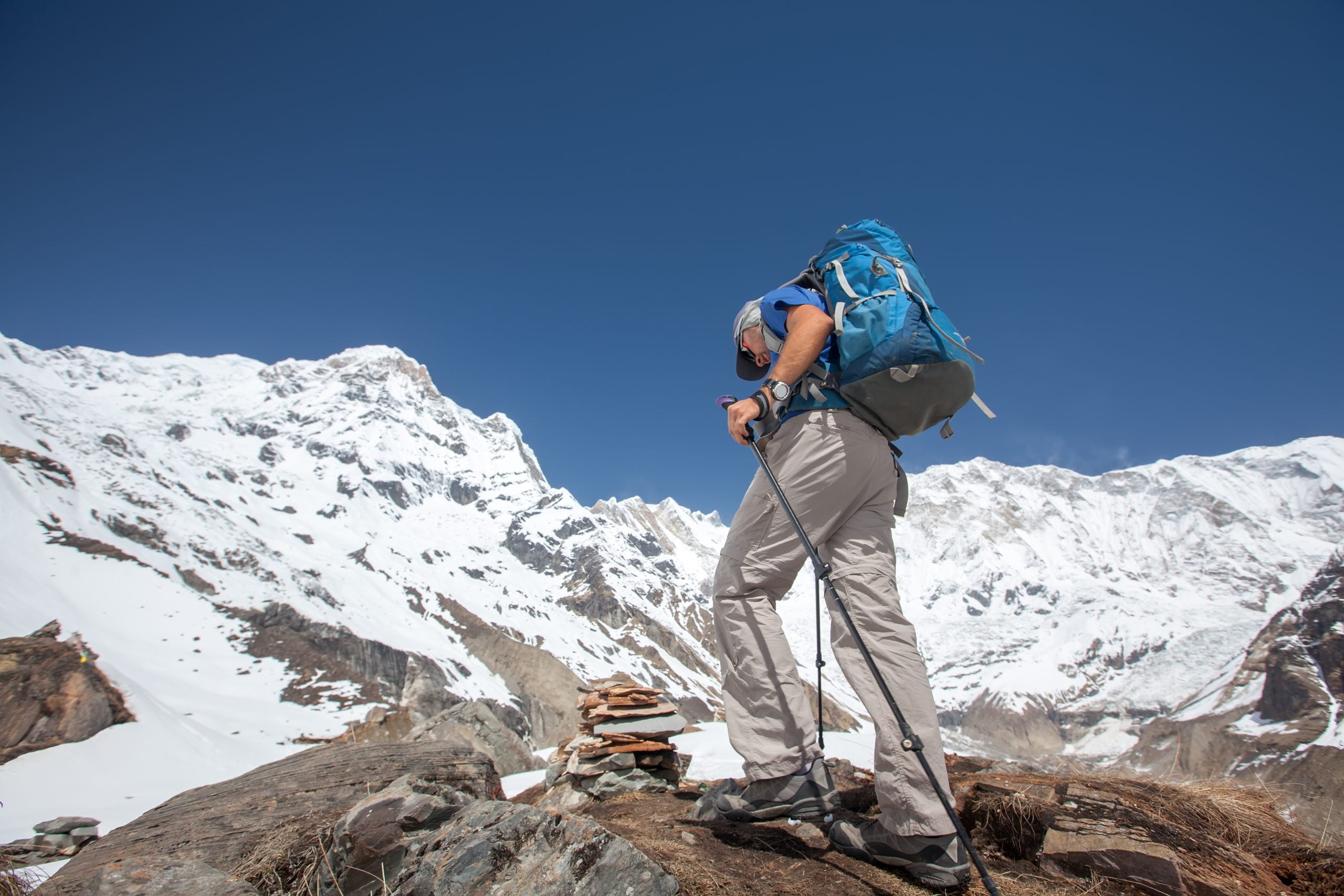
In the lower regions, comfortable tea houses sell local and Western foods (and beer) and luxury hotels. Many treks emphasize culture and scenery, but there are also plenty of opportunities to experience extreme isolation.
Round Annapurna Trek does not require you to be an expert hiker, but by the end, you will feel mountain-fit, suntanned, and upbeat! It’s safe to say this is a popular trek during the high season. So you’ll meet people from all over the world on the trail.
It isn’t easy at times, but the route allows for excellent acclimatization before attempting the pass, and you will be in our guide team’s safe and experienced hands.
Annapurna Trekking Guide Overview
Annapurna Circuit Trekking is one of the best walking trails in the world, passing through beautiful villages, waterfalls, and hot springs. This trek offers trekkers an opportunity to experience Tibetan, Buddhism, and rural mountain life and cross one of the wildest high mountain passes in one trip.
Trip Facts
Country: Nepal
Area: Annapurna Region
Duration: 15 Days
Group Size: 2-30
Grade: Challenging
Activity: Walking
Maximum Altitude: 5,416m (Thorong Pass)
Minimum Altitude: 1310 (Kathmandu)
Average Walking Hours: 6-7 hours per day
Number of Walking Days: 9
Accommodation: Three-star hotels in Kathmandu, Pokhara; Teahouse during trekking
Start point: Kathmandu
Ending Point: Kathmandu
Trip Highlights
- Stunning alpine meadows
- Trekking through the scenic Marshyangdi and Kali Gandaki river valleys
- Crossing the Thorong La Pass
- Insight into the rich traditions of Tibetan Buddhism
- Relaxing in the therapeutic hot springs at Tatopani
- Breathtaking views of some of the world’s highest peaks
About the Annapurna Circuit Trek
The Annapurna Circuit Trekking is widely regarded as one of the finest trekking trails in the world. While you can see lush forests, terraced fields, and densely populated civilizations in the lower region, the upper trans-Himalayan area is dry, barren, and rarely populated. Hindus mainly inhabit the lower region, while most upper areas are home to people following Buddhism.
This Round Annapurna Trek offers trekkers life experiences as they can witness great cultural, religious, and ecological diversity. The walk is pleasing as you hear birds chirping above the thick forest canopy and meet ever-smiling locals saying Namaste.
The Annapurna Trail crosses numerous rivers and creeks where you can see waterfalls cascading through lush forests into deep pools or fast-flowing rivers.
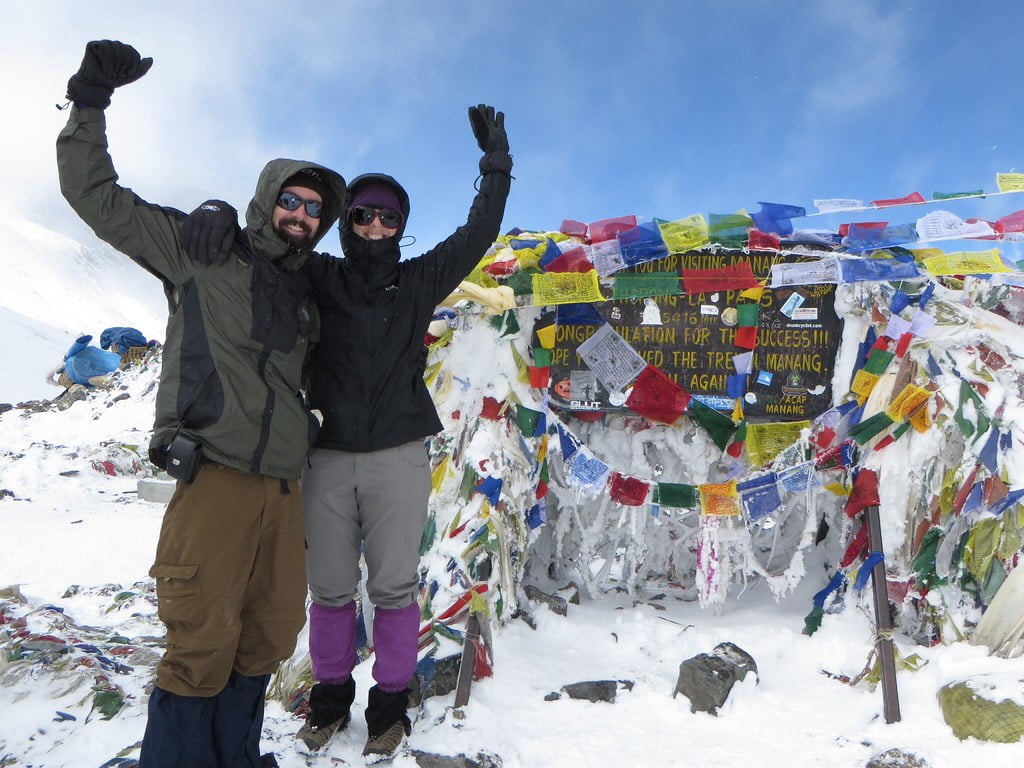
In the same way, vegetation ranges from sub-tropical and temperate forests in lower areas to subalpine and alpine forests in higher regions.
These forests are home to rare medicinal herbs like the caterpillar fungus locally known as Yarsagumba, which is believed to have aphrodisiac value. Similarly, endangered species like red panda, musk deer, and the elusive snow leopard are found here.
Mountain Views during Round Annapurna Trek
The trail lies between Dhaulagiri (8167m) and Annapurna (8091m), the 7th and 10th highest peaks globally. The Round Annapurna Trek offers spectacular views of mountain peaks like Gangapurna, Lamjung Himal, Manaslu, Pisang Peak, Chulu East, Chulu West, Nilgiri, Tukuche Peaks, and the omnipresent Machhapuchhre or the Fishtail.
You will also be walking through the deepest gorge in the world between Annapurna and Nilgiri mountains at Andhagalchhi (2,520m), which lies more than 5,000 meters below the summit of Mt Annapurna, making hiking the Annapurna Circuit Trekking a lifetime experience for many.
Annapurna Circuit Trekking Route Info
This 15-day Annapurna Circuit Trek kicks off with a picturesque drive from Kathmandu to Chamje. The trek follows the Marshyangdi River valley, leading you through charming villages like Dharapani, Chame, and Pisang before reaching the high-altitude village of Manang. As you ascend, the landscape transforms with Chortens, mani walls, and vibrant prayer flags, signaling your entry into a region rich in Buddhist culture.
Gradually, the trail rises to the Thorong La Pass at 5,416 meters, offering breathtaking views before descending into the Kali Gandaki River Valley. After crossing Thorong La, the route winds downhill, taking you past the sacred Muktinath Temple and traditional Thakali villages, famous for their warm hospitality and delicious local cuisine.
Along this part of the Annapurna Circuit, you’ll also encounter organic apple orchards, a specialty of the area. From Tatopani, the path crosses the Kali Gandaki River once again, climbing up to Shikha Village and then onto the well-known Ghorepani Poon Hill region.
At Poon Hill, you’ll enjoy a stunning sunrise over the mountains before descending through Ulleri to Tirkhedhunga, where a jeep awaits to take you back to the serene city of Pokhara.
Annapurna Base Camp Trekking Guide Itinerary
Day 1: Arrival in Kathmandu
Welcome to Nepal. After completing the immigration process and customs formalities, exit the airport, where our representative will be waiting for you. He will offer you a traditional Nepali welcome, escort you to your hotel, and assist you in check-in.
Take some rest to unwind after a long flight. If your arrival is earlier in the day, you can step out to your hotel neighborhood to get your first glimpses of Kathmandu or visit the Peregrine office. In the evening, there will be a trek briefing session, where you will meet your guide.
The guide will inform you about the trek and help you with the necessary trekking gear. After that, join us for a welcome dinner at a restaurant serving authentic Nepali food. Enjoy the meal and the traditional songs and dances performed by the artists.
O/N: Three-Star Hotel
Day 2: Drive to Chamje (1410m)
After early breakfast at your hotel, the journey begins with a drive to your trailhead at Chamje. The drive is pleasing as it passes through winding hills and beautiful riverside roads, offering a glimpse of the Nepali countryside.
It takes around six hours to reach Besishahar, a small hilly marketplace, where you will change vehicles for an incredible three-hour off-road drive.
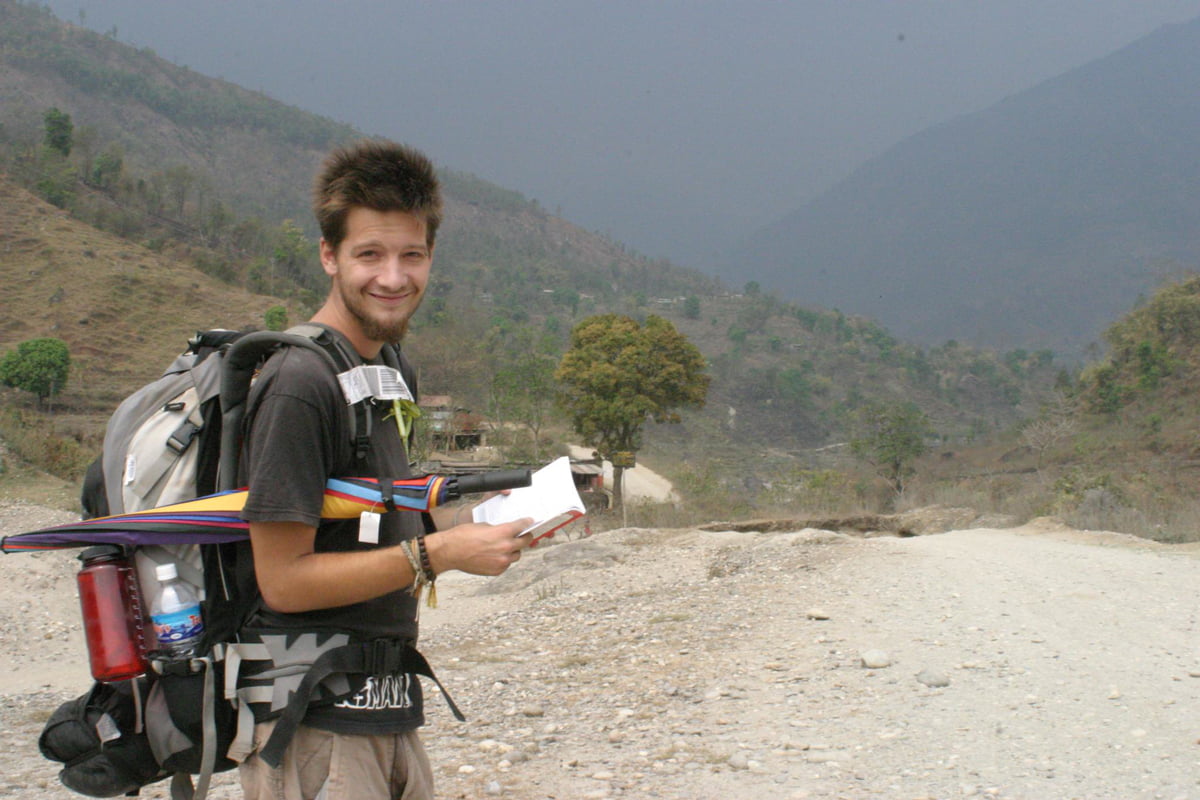
Expect some turbulence in the jeep ride as the road to the mountainside is in bad shape. Nevertheless, it is pleasing as it takes you through beautiful hamlets, rice terraces, rocky cliffs, and deep gorges. Upon arrival at Chamje, check in to your teahouse.
O/N: Teahouse
Day 3: Trek to Dharapani (1860m)
Your trek begins in earnest this day. After breakfast, follow your guide on a beautiful track with a series of uphill and downhill walks. The trail follows the Marshyangdi River and passes through waterfalls, rocky cliffs, and lush forests.
After a few hours’ walk, you will pass through an entry gate into the village of Taal (Lake). The narrow trail opens into a beautiful valley of Taal, where you will stop for lunch.
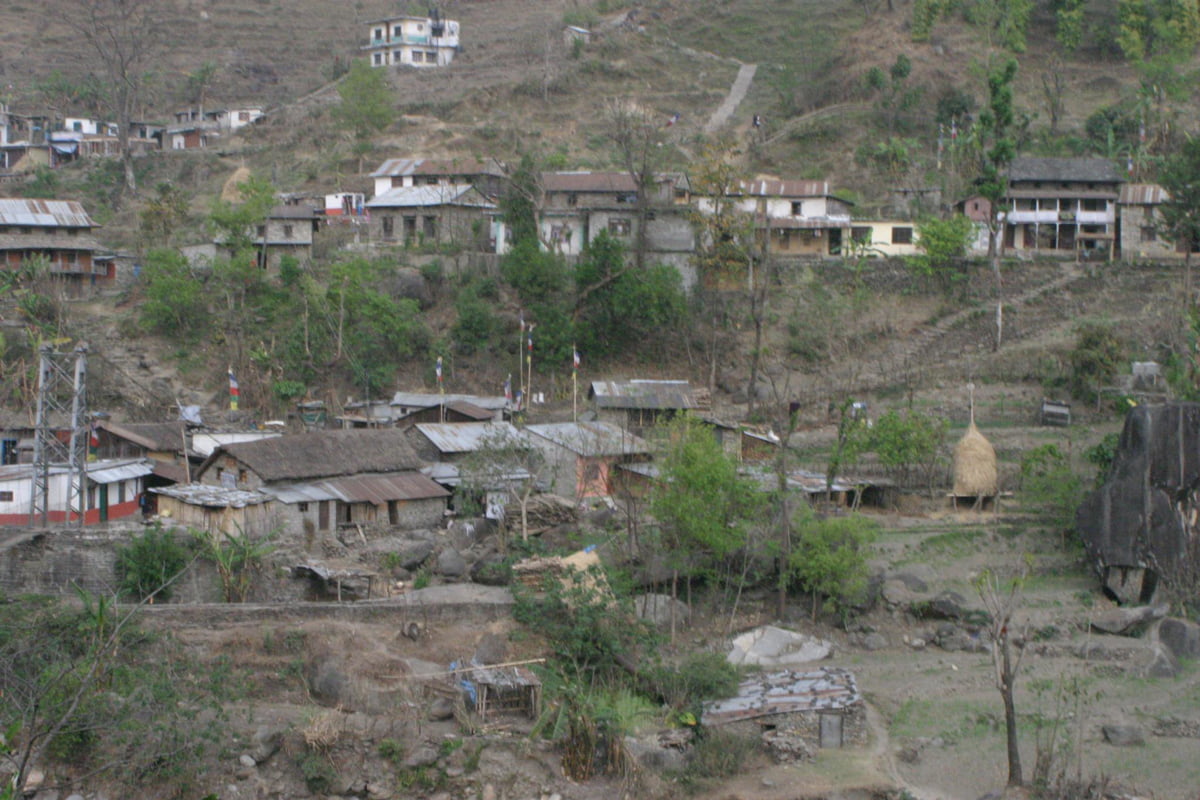
The area got its name when the river was dammed by landslide debris many years ago, creating an artificial lake. Taal is also the entry point of the Manang district, where a significant section of this trek lies.
After lunch, a brief leisurely walk will take you to Dharapani, where you will stop for the night. Before entering the village, you will see a Chorten, hinting that you are entering Buddhist land.
O/N: Teahouse
Day 4: Trek to Chame (2650m)
You will start early today as the trial is a bit longer. Hit the trail after a sumptuous breakfast at your lodge. The course is primarily uphill as you climb up into the alpine land. The trail passes through the beautiful villages of Bagarchhap and Danaque.
Rising further, you will reach the beautiful Tamang village, where the trail coming from the Manaslu region meets the Annapurna trail.
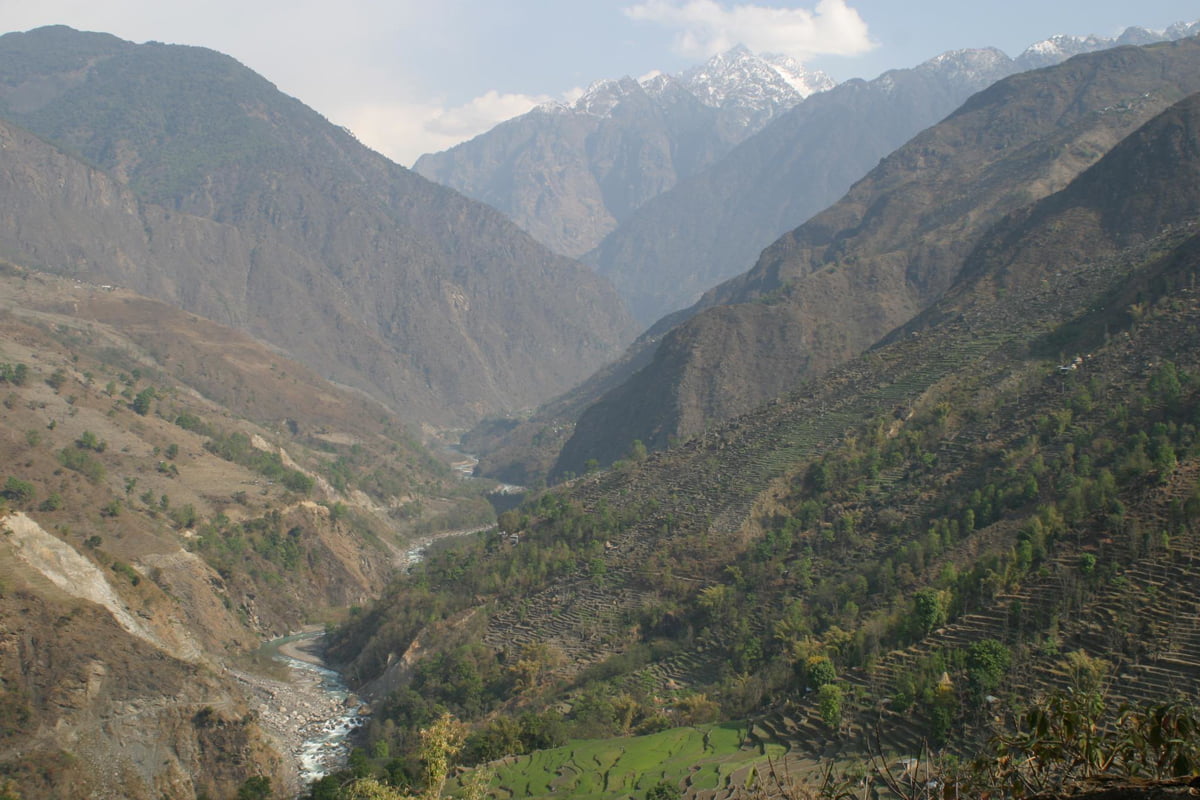
You can take a tea break here, admiring the beautiful view of Mt Manaslu (8163m) — the sixth-highest mountain in the world. Continue walking and pass through the lovely villages of Thanchowk and Koto, where the Nar-Phu trail joins the Annapurna Circuit trail, before entering Chame.
At the village entrance, a large mani wall with prayer wheels is visible. Chame is the district headquarters of Manang, and it has good hotels, Internet cafes, trekking gear shops, banks, and health and communication facilities, among other things.
O/N: Teahouse
Day 5: Trek to Upper Pisang (3300m)
On the fifth day of your Annapurna Circuit Trekking, you will resume walking after breakfast at your lodge. The trail from Chame passes through beautiful alpine forests in a narrow yet steep valley.
After crossing the Marshyangdi River on a suspension bridge, the trail climbs up, offering stunning views of rocky surfaces, including the face of Paungda Danda.
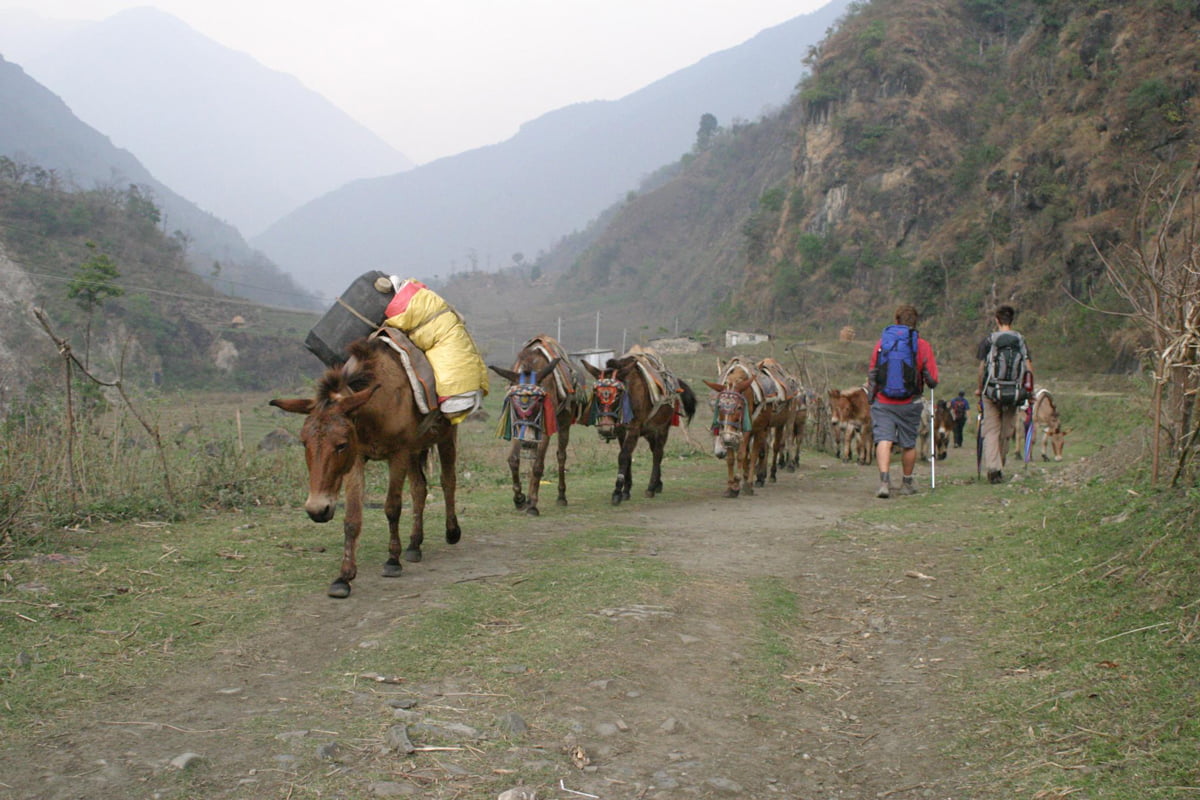
You will reach Dhukur Pokhari, where you will stop for lunch. After lunch, cross the river and start walking toward Upper Pisang.
Pisang offers you beautiful views of Pisang Peak and other peaks in the Annapurna Range to your south. Some trekkers may face breathing difficulty here as they enter the area with thin air. You will stop here for the night.
O/N: Teahouse
Day 6: Trek to Manang (3520m) via Ghyaru
The trail beyond Upper Pisang lies in the drier rain shadow area. There are two trails to Manang: the easy trail via the road and the Hongde airstrip, while the second is steep through the villages of Ghyaru and Ngawal.
You will take the second one as it offers breathtaking mountain views and helps you acclimate to higher altitudes. It passes through the beautiful settlement of Mungji and the hidden hamlet of Braga before reaching Manang.
Manang is one of the biggest villages on the Annapurna Circuit trail. All the facilities are here. A Himalayan Rescue Association (HRA) health post also provides information about altitude sickness.
O/N: Teahouse
Day 7: Rest Day for Acclimatization
Today, you will take a rest day to acclimate. You have many options today — exploring Baraka village, Manang village, or going to the Gangapurna viewpoint. The best option is a trek to the Gangapurna viewpoint, which will help you acclimate to higher altitudes.
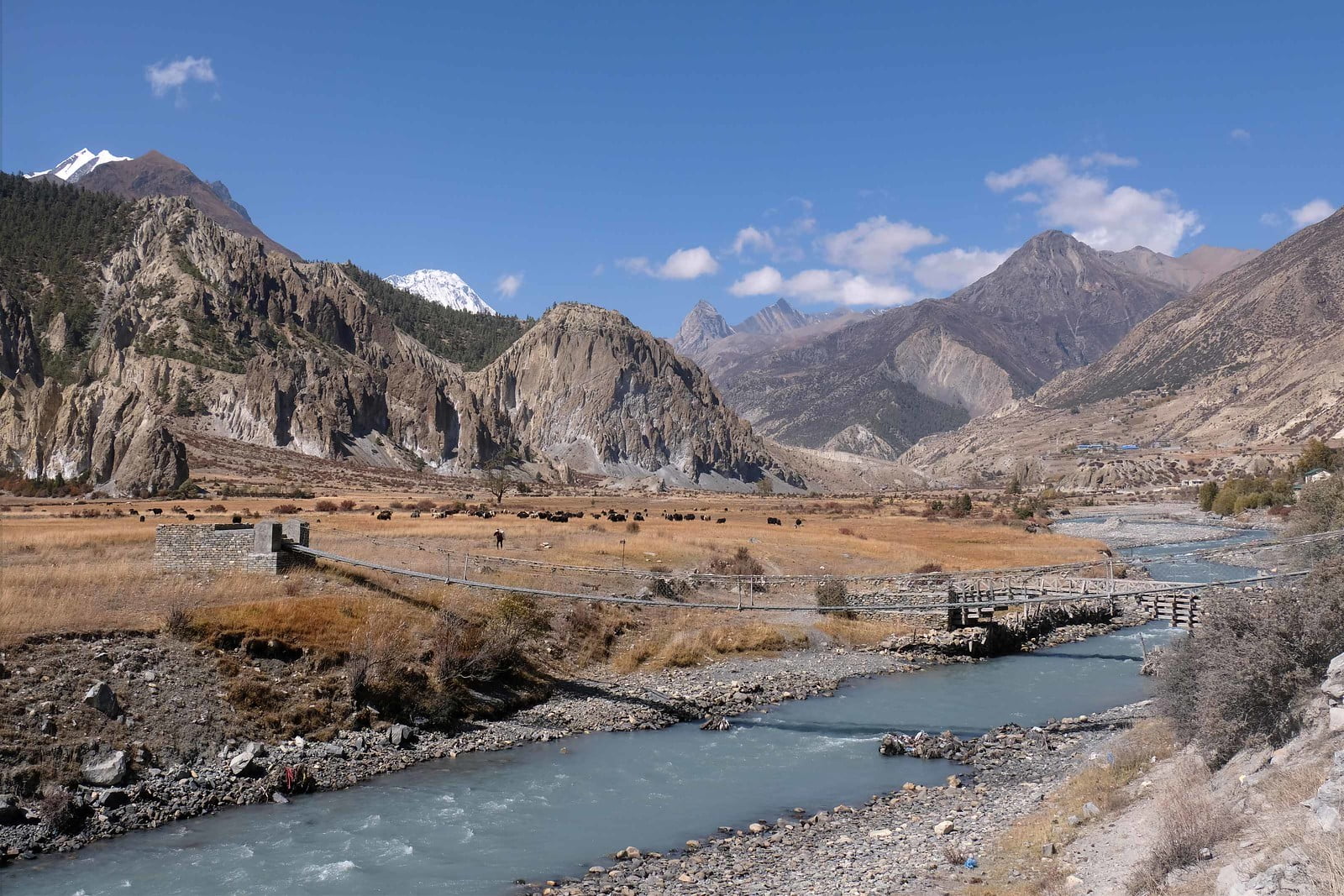
Enjoy a beautiful view of Gangapurna glacial lake, Gangapurna Glacier, and Thorong La Pass. Return to the teahouse for lunch. After lunch, attend a lecture on altitude sickness at the HRA health post. The doctors there will advise you on the necessary precautions that you should take to avoid altitude sickness.
O/N: Teahouse
Day 8: Trek to Yak Kharka (4035m)
The next three days will be the most difficult days of your trek as you ascend nearly 2,000 meters to Thorong Pass — the highest point of your trek. Beyond Manang, the trail leaves the Marshyangdi Valley and continues along the bank of its tributary Jarsang Khola.
As you gain altitude, the vegetation becomes shorter and sparser as you reach Yak Kharka. The Trail offers fantastic views of Annapurna II, III, IV, Tilicho Peak, and Gangapurna Peak. You can quickly get Letdar, but pressing further will not be wise. It’s free time for independent activities after lunch at Yak Kharka.
O/N: Teahouse
Day 9: Trek to Thorong Phedi/High Camp (4540m/4880m)
On this day, you will trek to Thorang Phedi or High Camp. It will take 3-4 hours to reach Thorong Phedi or the base of Thorong Pass, depending on your body and weather conditions. If the trail is snowy, it could take much longer. Walk slowly and steadily, following your guide.
Across the river on the other side of the course, you can see herds of blue sheep and Yaks grazing. There are few tea houses in Thorong Phedi. If you are not tired and willing to go further, you can trek to the High Camp, as it will make the next day’s walk easier. It’s your call.
O/N: Teahouse
Day 10: Trek to Muktinath (3800m) after crossing Thorong Pass (5416m)
This will be the longest and most challenging day of your Annapurna Circuit Trekking. Your guide will give you a wake-up call at 3 a.m. so you can start by 3:30 a.m. If you start from High Camp, you can create a bit later.
It is always wise to start early in the morning if you have to cross high passes because the passes could become windy from 11 a.m. onwards. The trail is very steep, but it is easy to follow. Crossing if the pass is covered with snow won’t be wise. Your guide will have the final say in that scenario.
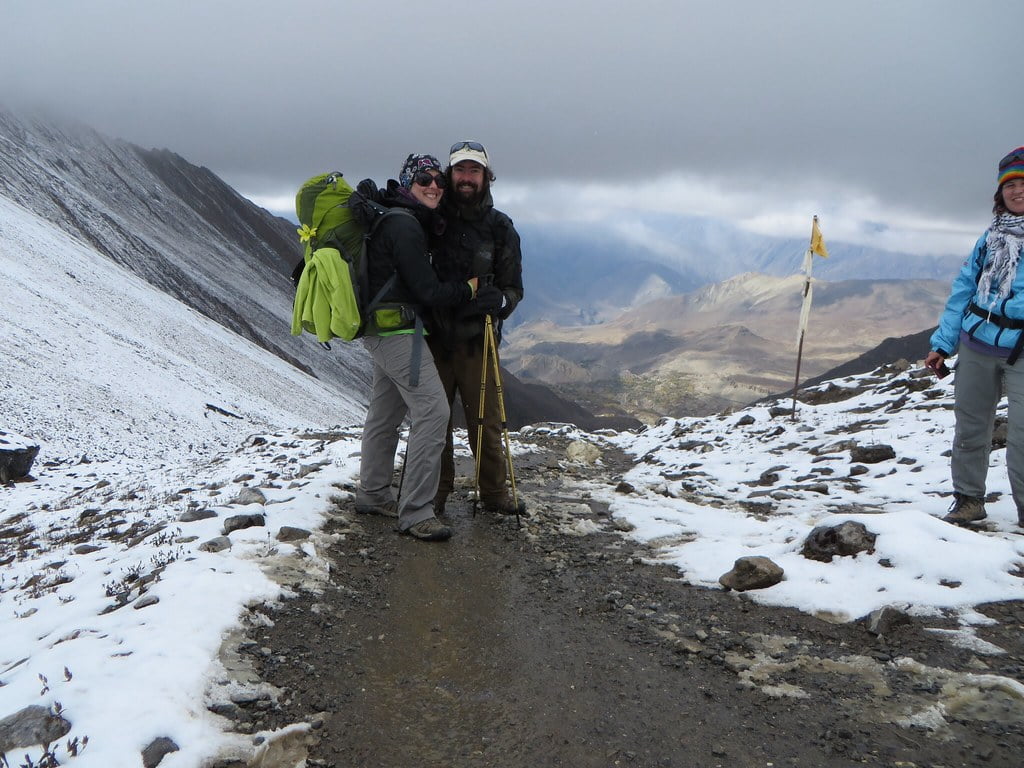
It will take around four to six hours to reach the pass. You can see Chorten and colorful prayer flags at the top. A signboard also says you are at the top of Thorong’s pass (5416m). Don’t forget to take a photo, keeping the signboard in the backdrop. You can enjoy breathtaking views all around.
The key divides two beautiful river valleys and watersheds — Marshyangdi Valley, from where you come to the top, and Kali Gandaki Valley, where you will descend. After spending some time at the top, enjoy your packed lunch and start a knee-busting descent to Muktinath (3800m). You will reach Muktinath by late afternoon.
O/N: Teahouse
Day 11: Jeep Drive to Tatopani (1100m)
In the morning, you will enjoy a short excursion to the Muktinath Temple. This temple is a joint pilgrimage for Hindus and Buddhists. There is also a holy flame fed by natural gas.
After breakfast, begin your drive toward Tatopani. Along the Kali Gandaki river, the industry passes through beautiful villages like Kagbeni and Jomsom—the district headquarters of Mustang—Marpha, Tukuche, and Lete.
Upon arrival at Tatopani, check into your teahouse. You can take a soothing bath in one of the natural hot springs in the village. The second leg of your trek begins today.
O/N: Teahouse
Day 12: Trek to Ghorepani (2800m)
Another long day in Round Annapurna Trek. After an early breakfast, cross the Kai Gandaki River and start uphill, walking toward Shikha village on the way to Ghorepani. A walk of about an hour or so will take you to a small settlement of Guthrie.
You can see lush vegetation and beautiful rice terraces in the village. You will pass through the Ghara settlement to your lunch point at Shikha village around noon. After Shikha, the trail to Ghorepani is mostly uphill. It passes through lush forests and rocky sections.
The final leg of the walk to Ghorepani is all on stone stairs. The Magar village saddles on a ridge and offers plenty of accommodation options. As it is one of the largest villages in the area, it is always overflowing with traders and tourists.
O/N: Teahouse
Day 13: Hike to Poon Hill (3210m), descend to Tikhedhunga, and drive to Pokhara
This is going to be the trek’s final walking day. We’ll be heading on a climb to the Poon Hill (3210m) viewpoint, so consider getting up early. Poon Hill, a little above Ghorepani village, commands a beautiful view of mountains in the Annapurna range.
You can enjoy amazing views of mountains like Annapurna South, Machhapuchhre, Himchuli, Annapurna III, Dhampus Peak, and Dhaulagiri, among others, from Poon Hill. After enjoying the view and taking pictures, walk down to Ghorepani.
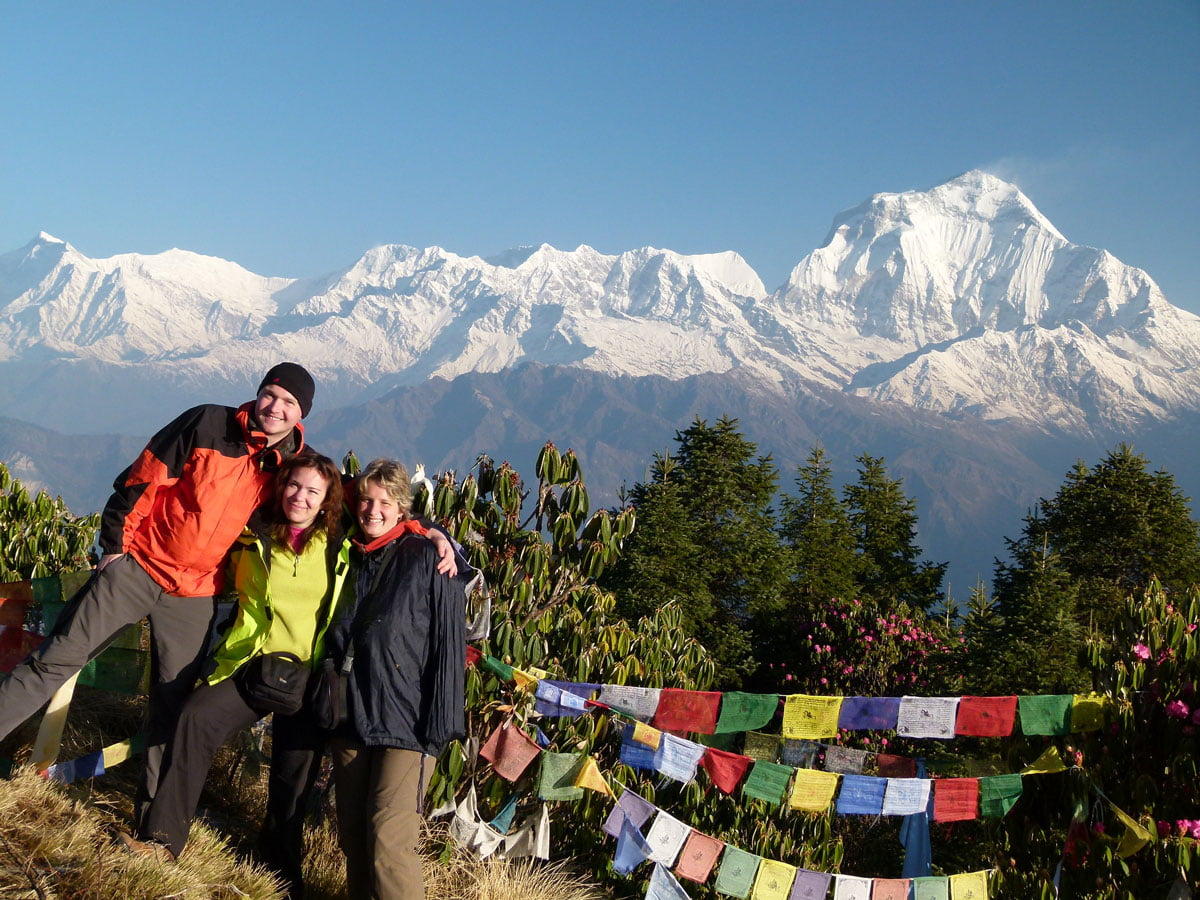
After breakfast, start walking toward Ulleri and then to Tirkhedhunga. It is an easy walk through beautiful rhododendron forests. At Tirkhedhunga, board a waiting car and drive toward Birethanti, Nayapul, and Pokhara.
Upon arrival in Pokhara, check into your hotel. You can fit a wide range of pubs and eateries in the Lakeside area to unwind after a long trek in the evening.
O/N: Three-star Hotel
Day 14: Drive to Kathmandu
On this day, you will be driving to Kathmandu. After early breakfast at your hotel, board a waiting car and start moving toward Kathmandu. We will stop for lunch somewhere along the highway and continue to Kathmandu.
The journey takes around seven hours. Upon arrival in Kathmandu, your guide will transfer you to your hotel. In the evening, we will host a farewell dinner where you can share your Annapurna Circuit Trekking experiences.
O/N: Three-star Hotel
Day 15: Departure
This is your last day in Nepal. After a leisurely breakfast, our representative will transfer you to the airport for your flight back home at least three hours before your flight. If your flight is late afternoon or evening, we can organize activities for you on request. Goodbye until we meet again.
Meals and Accommodation
You will be sharing in three-star hotels in Kathmandu and Pokhara. Your Annapurna Circuit Trekking package includes a complimentary breakfast. However, in Round Annapurna Trek, you will stay in a teahouse/lodge that may or may not have attached toilets.
During the trek, you will be served three meals daily: breakfast, lunch, and dinner. Generally, the Nepali staple Dal-Bhat-Tarkari (rice, lentils, and vegetables) is a meal. However, other dishes like pizza, pasta, noodles, etc., are also available.
Transportation
Transport is in a private, air-conditioned vehicle during the Round Annapurna Trek. However, air-conditioned cars won’t be available on dirt roads to the trekhead.
Essential Information of Annapurna Circuit Trekking Guide
1. Natural Experience

The Round Annapurna Trek is a treasure trove of natural beauty and cultural experiences. As you journey along this trail, you’ll encounter the true essence of Nepal, offering sights and sensations that may exceed your expectations. Highlights include lush forests, terraced rice fields, and panoramic views of iconic peaks like Fishtail (Machhapuchhre), Annapurna, Manaslu, and Dhaulagiri. Additionally, the sunrise from Poon Hill offers an unforgettable display of golden light on the Himalayas, making this trek a truly magical experience.
2. Getting there
3. Difficulty
The Round Annapurna Trek is a challenging journey, making it unsuitable for young children and senior citizens due to its demanding nature. Reaching a maximum altitude of 5,416 meters, this trek is the most popular in Nepal, offering well-maintained trails and solid infrastructure to support trekkers along the way.
4. Best Season
The Annapurna Circuit Trek can be done year-round, though autumn (mid-September to mid-November) and spring (March to May) are considered the best seasons due to ideal weather and comfortable temperatures. During these times, conditions are perfect for trekking, with clear skies and moderate temperatures. However, trekking is also possible in winter and monsoon seasons. For those who prefer a quieter experience and don’t mind more challenging conditions, winter and monsoon offer a less crowded alternative.
5. Packing List
Your packing list will vary depending on the season you choose for the trek. We’ll provide you with a detailed Annapurna Circuit Trek packing list to ensure you’re fully prepared. No specialized trekking gear is necessary for this route, and a three-season sleeping bag should be sufficient for comfort.
6. Trek Cost
The cost of the Annapurna Circuit Trek varies depending on the group size, services required, and whether you choose a standard or deluxe package. For solo trekkers, the price is USD 1690, but costs are reduced for groups of two or more.
The total cost will be higher if you prefer to take a flight from Jomsom or Pokhara to Kathmandu. We’re happy to customize this trek to suit your schedule and budget. Additionally, we offer complimentary services to international trek leaders and representatives from global travel agencies.
7. Extensions
You have the option to extend the Round Annapurna Trek by spending additional days in the region, giving you more time to immerse yourself in the local culture. Alternatively, you can enhance your trip by adding sightseeing tours in Kathmandu and Pokhara or try thrilling activities like rafting, bungee jumping, canyoning, and paragliding. For nature lovers, a jungle safari in Chitwan can be included as well. To wrap up your adventure, consider a scenic mountain flight for breathtaking aerial views of the Himalayas from the comfort of your seat.
Relevant link of Annapurna Circuit Trekking
Annapurna Base Camp Trek: https://peregrinetreks.com/annapurna-base-camp-trek/
Ghorepani Poonhill Trekking: https://peregrinetreks.com/ghorepani-poon-hill-trekking/
Annapurna Circuit Trek: https://peregrinetreks.com/annapurna-circuit-trek/
ABC Short Trek: https://peregrinetreks.com/annapurna-base-camp-short-trek
Mardi Himal Trekking: https://peregrinetreks.com/mardi-himal-trekking/
Tilicho Lake Trekking: https://peregrinetreks.com/tilicho-lake-trekking/
Annapurna Mini Trek: https://peregrinetreks.com/annapurna-mini-trek
Annapurna View Trekking: https://peregrinetreks.com/annapurna-view-trekking/
Useful to know
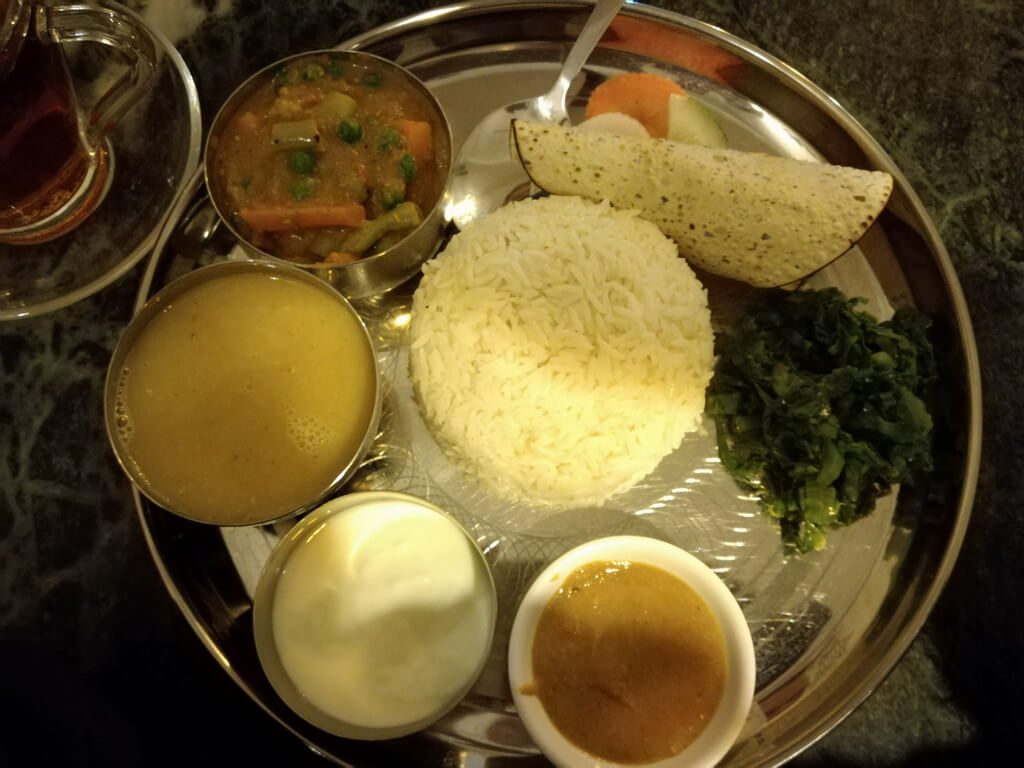
Do’s
- Say Namaste and greet with a smile.
- Do walk in a group
- Consult a guide for any information you require.
- Inform your guide if you experience discomfort or extreme fatigue.
- Capture the once-in-a-lifetime moments with your camera.
Don’ts
- Do not belittle other cultures or religions.
- Take no photographs of locals without their permission.
- Try not to be shocked if people stare at you; they wonder about you.
- Don’t bring any lethal weapons with you.
- Avoid harming plants, birds, and wild animals.
- Don’t be afraid to decline vendors’ offers politely.
Best Time for Annapurna Circuit Trekking
The Annapurna Circuit Trekking is moderately challenging but exciting. However, you should remember that this trek has specific requirements that you should know before you begin.
The best time to visit the Annapurna Region in the spring is April and May, and the best time to visit in the autumn is October and November. The weather is clear and dry at this time of year. These two seasons are also the busiest times to be on the route, with trekkers from all over the world entering the Himalayas.
You can also trek at other times of the year, but you must be more prepared for severe weather conditions. Clear skies and spectacular views are also possible during the winter season, from December to March.
However, it can be freezing at higher altitudes, with thick snow on the ground, suddenly causing the Thorong La Pass to close. If you plan to trek during the winter, bring extra layers, a thick sleeping bag suitable for temperatures of at least -20°C, and climbing gear, which can be purchased in Kathmandu and Pokhara.
Annapurna Circuit Climate
Nepal’s second most famous trek is the Annapurna Circuit, which covers a range from subtropical meadows to semi-arid lands. The trek’s climatic changes are remarkable.
The Round Annapurna Trek includes a crossing of the 5416-meter-high Thorung La pass. The pass’s summit is higher in elevation than Everest Base Camp. If you attempt to climb the pass during a difficult season, it is a nerve-racking experience. However, the Annapurna Circuit Trekking is attainable throughout Nepal’s four seasons. This trek can be comfortable and thriving with the proper planning, equipment, and supplies.
Required Equipment for Annapurna Circuit Trekking
The list below provides an overview of the trekking equipment and clothing required for the Annapurna Circuit Trekking. This will vary depending on your personal needs and the conditions of the Trek.
- A sleeping bag
- Duffel Bag
- Down jacket (Must have for mornings, nights, evenings, and altitudes above 13,000 feet.)
1. Upper Body – Head / Ears / Eyes
- Sun Hat
- A hat made of wool or synthetic material that covers the ears
- Sunglasses with UV protection
- Head Torch
- Neckwarmer
- Scarfs
2. Hand
- Liner gloves
- Heavier shell gloves (For winter)
3. Core Body
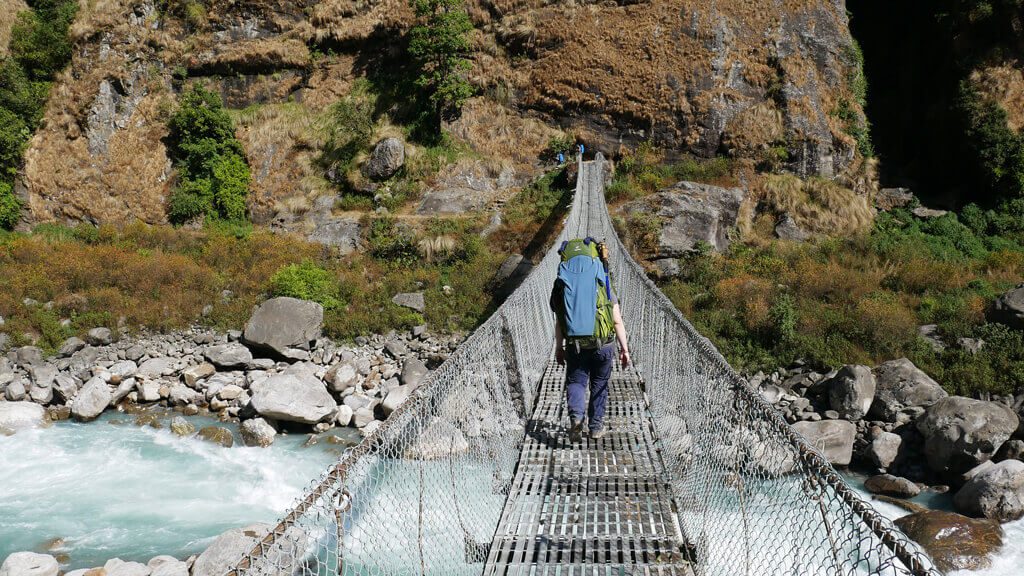
- T-shirts (2)
- Lightweight expedition thermal tops
- Fleece jacket or pullover
- Water/windproof shell jacket (preferably breathable fabric)
- Synthetic sports bras (for women)
4. Lower Body – Legs
- Lightweight expedition thermal bottoms
- Nylon hiking shorts
- Softshell and hardshell trekking pants
- Water/windproof trousers
- Casual pants
5. Feet
- Liner socks
- Heavyweight socks (For winter)
- Waterproof hiking/trekking boots
- Light shoes/sneakers
- Gaiters (For monsoon and winter)
6. Medicines And First Aid Kits
(Peregrine’s team will carry the first-aid kit bag during the Round Annapurna Trek. However, we still recommend you bring your personalized first-aid kit.)
- Extra Strength Excedrin for altitude-related headaches
- Ibuprofen for general aches and pains
- Immodium or Pepto Bismol capsules for upset stomach or diarrhea
- Diamox (commonly prescribed as Acetazolamide) 125 or 250mg tablets for altitude sickness
- Anti-infection ointments
- Band-aids
- Lip balm (At least SPF 20)
- Sunscreen (SPF 40)
7. Miscellaneous but Important!
- Passport and extra passport photos (3 copies)
- Airline tickets
- Durable wallet/pouch for travel documents, money & passport
- Water bottle
- Water purification Iodine tablets
- Toiletry kit (Be sure to include toilet paper stored in a plastic bag, hand wipes, liquid hand sanitizer, towel, soap, etc.)
8. Optional
- Adjustable trekking poles
- Favorite snack foods (No more than 2 pounds)
- Paperback, cards, mp3 player, headphones
- Binoculars
- Power Bank
- Cameras (Memory cards, chargers, and also batteries)
- A pee bottle for men and a pee funnel for women
Please note that this is just a guide.
Frequently Asked Questions (FAQs)
Q1. Where is the Annapurna Circuit located?
The Annapurna Circuit Trek is situated in western Nepal, between the towering Dhaulagiri and Annapurna mountain ranges. This iconic trek offers a chance to explore the region’s dramatic landscapes and diverse cultures.
Q2. How long does it take to complete the Annapurna Circuit Trek?
The trek typically takes about 14 to 16 days, depending on the pace of the group and any extra days taken for acclimatization or side trips along the route.
Q3. What is the best season to trek the Annapurna Circuit?
The ideal time for the Annapurna Circuit Trek is during autumn (September to November), right after the monsoon season, when the skies are clear and visibility is excellent. Spring (March to April) is also a fantastic time to visit, as wildflowers like rhododendrons bloom along the trail. That said, the trek can technically be done year-round, though conditions vary.
Q4. How fit do I need to be to trek the Annapurna Circuit?
This moderately challenging trek requires a good level of physical fitness. While most healthy individuals can complete it, it’s unsuitable for young children or elderly individuals who might find the altitude and long trekking days too demanding.
Q5. How many hours will I be walking each day?
On average, expect to trek 6 to 7 hours daily, covering varying terrains and altitudes. Some days may be shorter or longer, depending on the day’s itinerary and altitude acclimatization needs.
Q6. What permits are required for Annapurna Circuit Trekking?
To trek in the Annapurna region, you’ll need two essential permits: the Annapurna Conservation Area Permit (ACAP) and a TIMS (Trekkers’ Information Management System) card. The ACAP permit grants entry to the Annapurna Conservation Area, while the TIMS card is necessary for trekking on major trails in Nepal, including the Annapurna Circuit.
Q7. What is the highest point on the Annapurna Circuit?
The trek’s highest altitude is at Thorong La Pass, which is 5,416 meters (17,769 feet). This is a highlight of the trek, offering breathtaking panoramic views of the surrounding Himalayan peaks.
Q8. What type of accommodation can I expect on the Annapurna Circuit?
During the trek, you’ll stay in lodges or teahouses along the trail. In Kathmandu and Pokhara, you’ll stay in hotels with standard amenities. Teahouses on the trek provide basic but comfortable lodging with meals.
Q9. Will I have access to the internet on the Annapurna Circuit?
Yes, internet access is available in many villages along the trek, though the speed and reliability may vary, especially at higher altitudes. Expect slower connections than you might be used to back home.
Q10. Are there ATMs along the Annapurna Circuit?
No, ATMs are not available once you begin the trek. Before starting your trek, make sure to withdraw enough cash in Besishahar or Kathmandu to cover any expenses along the way.
Q11. Should I hire a guide or use an agency for the Annapurna Circuit Trek?
While it’s possible to trek the Annapurna Circuit independently, hiring a licensed guide or agency is recommended for your comfort and safety. A professional guide can enhance your experience by providing insights into the local culture, helping with logistics, and ensuring your well-being.
